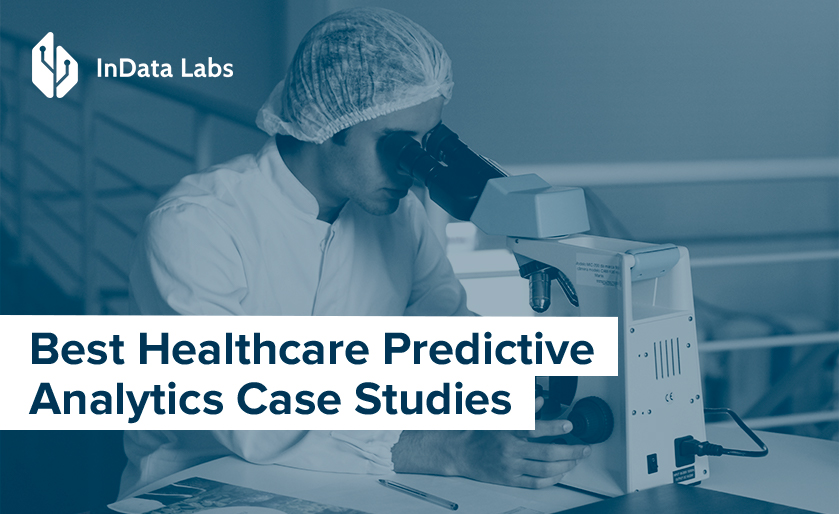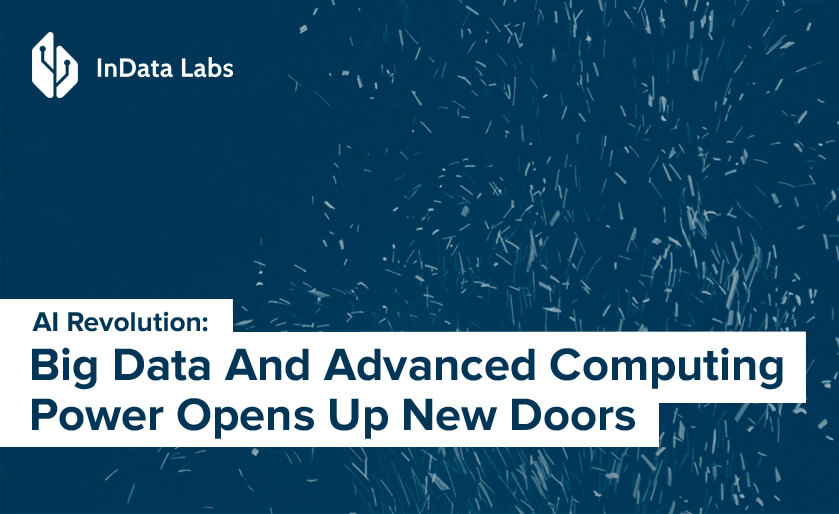The far-reaching consequences of the global COVID-19 pandemic and the high odds of recession have driven organizations to realize the potential of automation for business continuity. As a result, over the last few years, we have witnessed an all-time high number of artificial intelligence case studies.
According to McKinsey, 57 percent of companies report AI adoption, up from 45 percent in 2020. The majority of these applications targeted the optimization of service operations, a much-needed shift in these turbulent times. Beyond service optimization, AI case studies have been spotted across virtually all industries and functional activities.
Today, we’ll have a look at some of the most exciting business use cases that owe their advent to artificial intelligence and its offshoots.
What is the business value of artificial intelligence?
According to PwC, AI development can rack in an additional $15.7 trillion of the global economic value by 2030. In 2022, 92% of respondents have indicated positive and measurable business results from their prior investments in AI and data initiatives.

However, there are other benefits that incentivize companies to tap into artificial intelligence case studies.
Reduced costs
The cost-saving potential of AI systems stems from automated labor-intensive processes, which leads to reduced operational expenses. For example, Gartner predicts that conversational AI will reduce contact center labor costs by $80 billion in 2026.
Indirect cost reduction of smart systems is associated with optimizing operations with precise forecasting, predictive maintenance, and quality control.
Amplified decision-making
AI doesn’t just cut costs, it expands business brainpower in terms of new revenue streams and better resource allocation. Smart data analysis allows companies to make faster, more accurate, and consistent decisions by capitalizing on datasets and predicting the optimal course of action. AI consulting comes in especially handy when bouncing back from crises.

Source: Unsplash
Lower risks
From workplace safety to fraud detection to what-if scenarios, machine learning algorithms can evaluate historical risk indicators and develop risk management strategies. Automated systems can also be used to automate risk assessment processes, identify risks early, and monitor risks on an ongoing basis. Thus, 56% of insurance companies see the biggest impact of AI in risk management.
Better business resilience
Automation and advanced analytics are becoming key enablers for combating risks in real-time rather than taking a retrospective approach. As 81% of CEOs predict a recession in the coming years, companies can protect their core by predicting transition risks, closing supply and demand gaps, and optimizing resources – based on artificial intelligence strategy.

Source: Unsplash
Top 10 AI case studies: from analytics to pose tracking
Now let’s look into the most prominent artificial intelligence case studies that are pushing the frontier of AI adoption.
Alibaba
Industry: E-commerce and retail
Application: AI-generated marketing, personalized recommendations
A Chinese E-commerce giant, Alibaba is the world’s largest platform with recorded revenue of over $93.5 billion in Chinese online sales. No wonder, that the company is vested in maximizing revenue by optimizing the digital shopping experience with artificial intelligence.
Its well-known case study on artificial intelligence includes an extensive implementation of algorithms to improve customer experience and drive more sales. Alibaba Cloud Artificial Intelligence Recommendation (AIRec) leverages Alibaba’s Big data to generate real-time, personalized recommendations on Alibaba-owned online shopping platform Taobao and across the number of Double 11 promotional events.
The company also uses NLP to help merchants automatically generate product descriptions.

Source: Unsplash
Mayo Clinic
Industry: healthcare
Application: medical data analytics
Another AI case study in the list is Mayo Clinic, a hospital and research center that is ranked among the top hospitals and excels in a variety of specialty areas. Intelligent algorithms are used there in a large number of business use cases – both administrative and clinical.
The use of computer algorithms on ECG in Mayo’s cardiovascular medicine research helps detect weak heart pumps by analyzing data from Apple Watch ECGs. The research center is also a staunch advocate of AI medical imaging where machine learning is applied to analyze image data fast and at scale.

Source: Unsplash
As another case study on artificial intelligence in healthcare, Mayo Clinic has also launched a new project to collect and analyze patient data from remote monitoring devices and diagnostic tools. The sensor and wearables data can then be analyzed to improve diagnoses and disease prediction.
Deutsche Bank
Industry: banking
Application: fraud detection
Now, let’s look at artificial intelligence in the banking case study brought up by Deutsche Bank and Visa. The two companies partnered up in 2022 to eliminate online retail fraud. Merchants who process their E-commerce payments via Deutsche Bank can now rely on a smart fraud detection system from Visa-owned company Cybersource.
Driven by pre-defined rules, the system automatically calculates a risk value for each transaction. The system employs risk models and data from billions of data points on the Visa network. This allows for blocking fraudulent transactions and faster authorizing other transactions.
Amazon
Industry: E-commerce
Application: supply and demand prediction
Amazon is a well-known technology innovator that makes the most of artificial intelligence. From data analysis to route optimization, the company injects automation at all stages of the whole supply chain. Over the last few years, the company has perfected its forecasting algorithm to make a unified forecasting model that predicts even fluctuating demand.

Source: Unsplash
Let’s look at its AI in E-commerce case study. When toilet paper sales surged by 213% during the pandemic, Amazon’s predictive forecasting allowed the company to respond quickly to the sudden spike and adjust the supply levels to the market needs.
Blue River Technology
Industry: agriculture
Application: computer vision
This AI case study demonstrates the potential of intelligent machinery in improving crop yield. Blue River Technology, a California-based machinery enterprise, aims to radically change agriculture through the adoption of robotics and machine learning. The company equips farmers with sustainable and effective intelligent solutions to manage crops.
Their company’s flagship product, See & Spray, relies on computer vision, machine learning, and advanced robotic technology to distinguish between crops and weeds. The machine then delivers a targeted spray to weeds. According to the company, this innovation can reduce herbicide use by up to 80 percent.

Source: Unsplash
BMW
Industry: automotive
Application: voice recognition
The car manufacturer has over 400 AI & ML case studies at all levels of production. According to the company, these technologies play an essential role in the production of new vehicles and augment automated driving with advanced, natural experience.
In particular, voice recognition allows drivers to adjust the in-car settings such as climate and driving mode, or even choose the preferred song. BMW owners can also use the voice command to ask the car about its performance status, get guidance on specific vehicle functions, and input a destination.

Source: Unsplash
Affectiva
Industry: media and entertainment
Application: emotion recognition
Another exciting case study about artificial intelligence is Affectiva company and its flagship AI products. The company conceived a new technological dimension of Artificial Emotional Intelligence, named Emotion AI. This application allows publishers to optimize content and media spending based on the customers’ emotional responses.
Emotion AI is fuelled by a combination of computer vision and deep learning to discern nuanced emotions and cognitive states by analyzing facial movement.

Source: Unsplash
Siemens
Industry: manufacturing
Application: process optimization
As global enterprises are looking for more ways to optimize, the demand for automation grows. Siemens’ collaboration with Google is a prominent case study on the application of artificial intelligence in factory automation. The manufacturer has teamed up with Google to drive up shop floor productivity with edge analytics.
The expected results are to be achieved via computer vision, cloud-based analytics, and AI algorithms. Optimization will most likely leverage the connection of Google’s data cloud with Siemens’ Digital Industries Factory Automation tools. This will allow companies to unify their factory data and run cloud-based analytics and AI at scale.
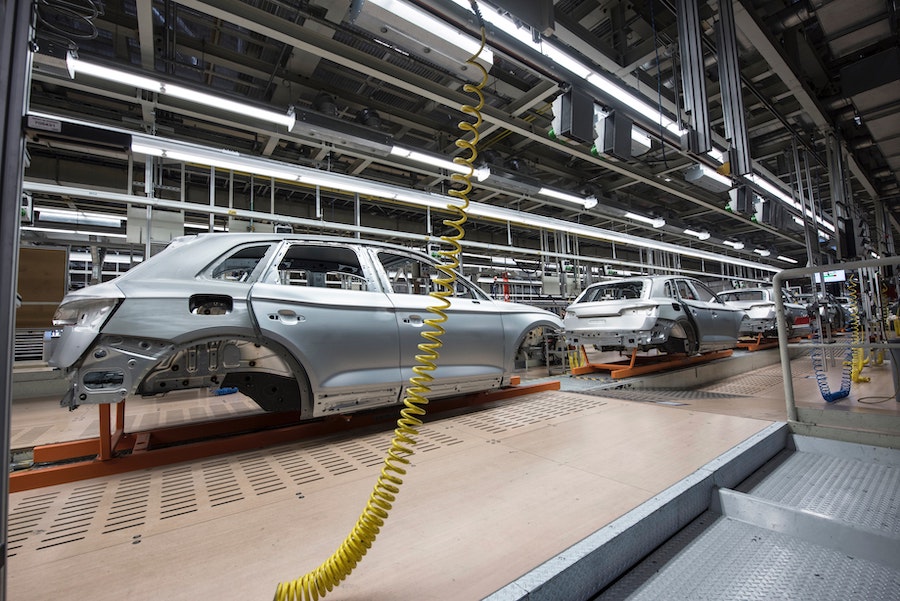
Source: Unsplash
Samsung
Industry: manufacturing
Application: semiconductor development
Along with cutting-edge solutions like its memory accelerator, the manufacturing conglomerate also implements AI to automate the highly complex process of designing computer chips. A prominent artificial intelligence case study is Samsung using Synopsys AI software to design its Exynos chips. The latter are used in smartphones, including branded handsets and other gadgets.
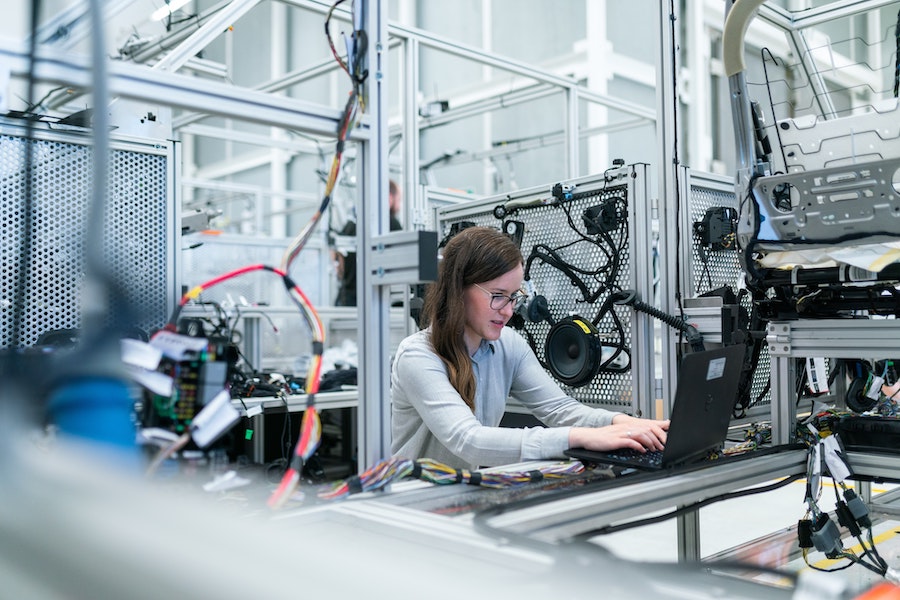
Source: Unsplash
Frito-Lay
Industry: manufacturing
Application: predictive maintenance
According to McKinsey, the greatest value from AI in manufacturing will be delivered from predictive maintenance, which accounts for $0.5-$0.7 trillion in value worldwide. The snack food manufacturer and PepsiCo’s subsidiary, Frito-Lay, has followed suit.
The company has a long track record of using predictive maintenance to enhance production and reduce equipment costs. Paired with sensors, this case study of artificial intelligence helped the company reduce planned downtime and add 4,000 hours a year of manufacturing capacity.
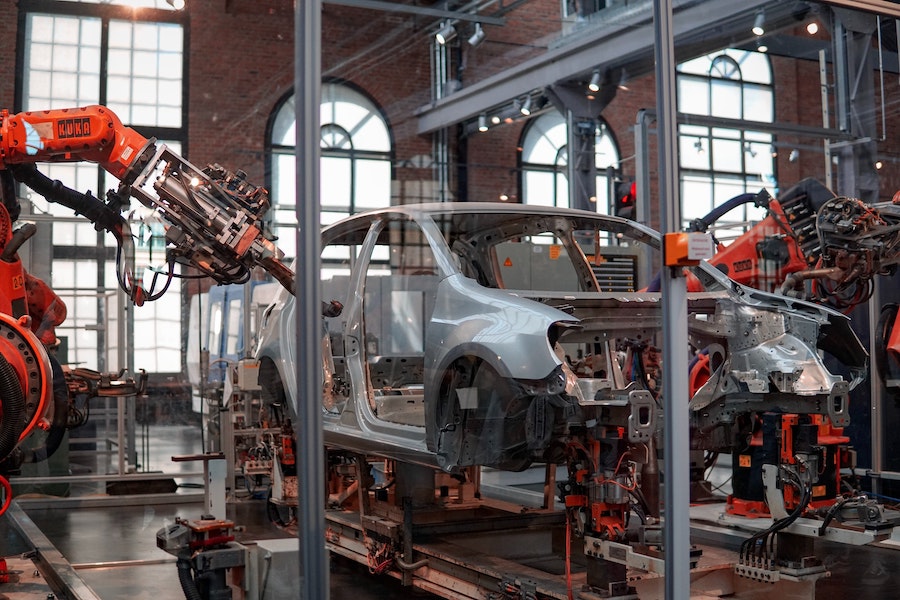
Source: Unsplash
Looking over horizon: Technology trends for 2023-2024
Although artificial intelligence case studies are likely to account for the majority of innovations, the exact form and shape of intelligent transformation can vary. Below, you will find the likely successors of AI technologies in the coming years.
Applied AI
Applied AI is the use of artificial intelligence to solve real-world problems. This AI case study example is different from general machine intelligence in that it is focused on specific tasks or problems such as increasing sales, reducing costs, or analyzing customer feedback rather than hypotheses. 
Advanced connectivity
Advanced connectivity refers to the various ways in which devices can connect and share data. It includes technologies like 5G, the Internet of Things, edge computing, wireless low-power networks, and other innovations that facilitate seamless and fast data sharing.
The global IoT connectivity imperative has been driven by cellular IoT (2G, 3G, 4G, and now 5G) as well as LPWA over the last five years. Growing usage of medical IoT, IoT-enabled manufacturing, and autonomous vehicles have been among the greatest market enablers so far.

Web 3.0
Web 3.0 is the new iteration of the Internet that aims to make the digital space more user-centered and enables users to have full control over their data. The concept is premised on a combination of technologies, including blockchain, semantic web, immersive technology, and others.
Metaverse
Metaverse generally refers to an integrated network of virtual worlds accessed through a browser or headset. The technology is powered by a combination of virtual and augmented reality.
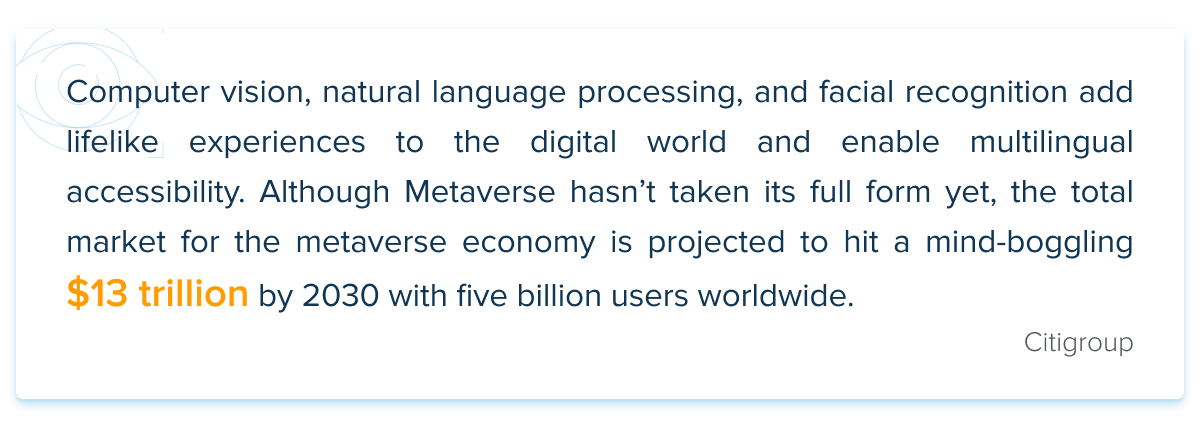
Edge computing
Edge computing takes cloud data processing to a new level and focuses on delivering services from the edge of the network. The technology will enable faster local AI data analytics and allow smart systems to deliver on performance and keep costs down. Edge computing will also back up autonomous behavior for Internet of Things (IoT) devices.
Industries already incorporate devices with edge computing, including smart speakers, sensors, actuators, and other hardware.

Augmented analytics
Powered by ML and natural language technologies, augmented analytics takes an extra step to help companies glean insights from complex data volumes. Augmented analytics also relies on extensive automation capabilities that streamline routine manual tasks across the data analytics lifecycle, reduce the time needed to build ML models, and democratize analytics.
Large-sized organizations often rely on augmented analytics when scaling their analytics program to new users to accelerate the onboarding process. Leading BI suites such as Power BI, Qlik, Tableau, and others have a full range of augmented analytics capabilities.

Engineered decision intelligence
The field of decision intelligence is a new area of AI that combines the scientific method with human judgment to make better decisions. In other words, it’s a way to use machine intelligence to make decisions more effectively and efficiently in complex scenarios.
Today, decision intelligence assists companies in identifying risks and frauds, improving sales and marketing as well as enhancing supply chains. For example, Mastercard employs technology to increase approvals for genuine transactions.

Data Fabric
Being a holistic data strategy, data fabric leverages people and technology to bridge the knowledge-sharing gap within data estates. Data fabric is based on an integrated architecture for managing information with full and flexible access to data.
The technology also revolves around Big data and AI approaches that help companies establish elastic data management workflows.

Quantum computing
An antagonist of conventional computing, the quantum approach uses qubits as a basic unit of information to speed up analysis to a scale that traditional computers cannot ever match. The speed of processing translates into potential benefits of analyzing large datasets – faster and at finer levels.

Hyperautomation
This concept makes the most of intelligent technologies to help companies achieve end-to-end automation by combining AI-fuelled tools with Robotic Process Automation. Hyperautomation strives to streamline every task executed by business users through ever-evolving automated pathways that learn from data.
Thanks to a powerful duo of artificial intelligence and RPA, the hyperautomated architecture can handle undocumented procedures that depend on unstructured data inputs – something that has never been possible.

Turning a crisis into an opportunity with AI
In the next few years, businesses will have to operate against the backdrop of the looming recession and financial pressure. The only way of standing firmly on the ground is to save resources, which usually leaves just two options: layoffs or resource optimization.
While the first option is a moot point, resource optimization is a time-tested method to battle uncertainty. And there’s no technology like artificial intelligence that can better audit, identify, validate, and execute the optimal transition strategy for virtually any industry. From better marketing messages to voice-controlled vehicles, AI adds a new dimension to your traditional business operations.
AI technology to combat recession
Schedule an intro call with our AI consulting experts to explore your business and find out how we can help.


